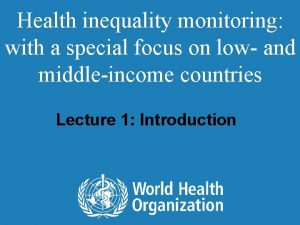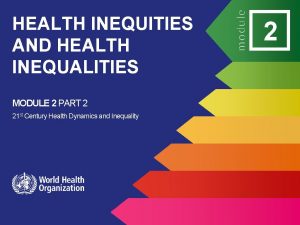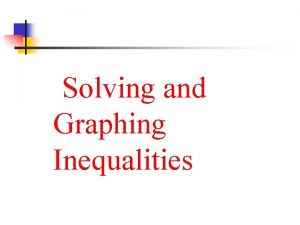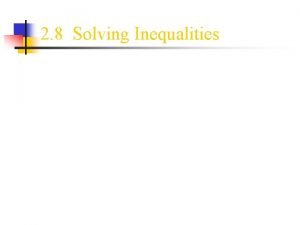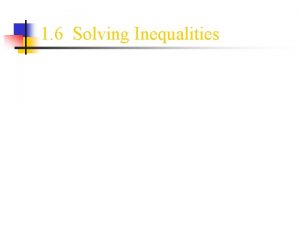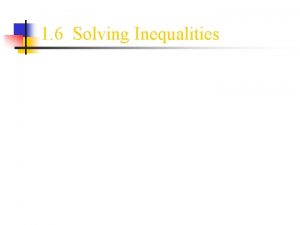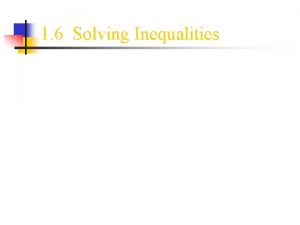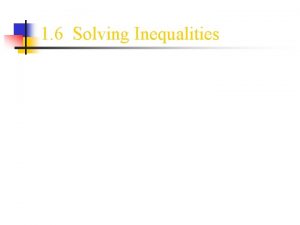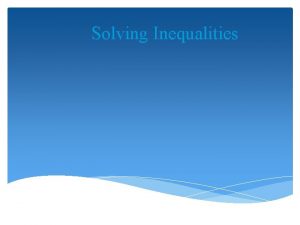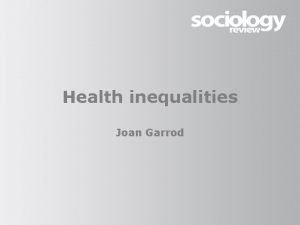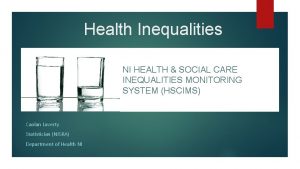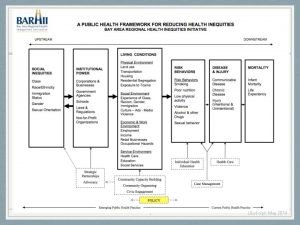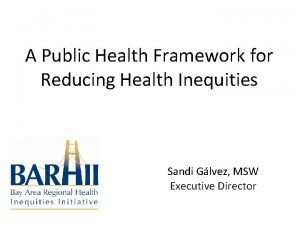HEALTH INEQUITIES AND HEALTH INEQUALITIES MODULE 2 PART























- Slides: 23

HEALTH INEQUITIES AND HEALTH INEQUALITIES MODULE 2 PART 2 21 st Century Health Dynamics and Inequality 2

2 LEARNING OBJECTIVES 1 Distinguish between the underlying concepts of health inequality and health inequity 2 Explain how societal inequalities influence health outcomes

2 HEALTH EQUITY VS HEALTH EQUALITY A VISUAL DEPICTION OF THE DIFFERENCE BETWEEN EQUALITY AND EQUITY

2 HEALTH EQUITY THE WORLD HEALTH ORGANIZATION DEFINES HEALTH EQUITY AS: “ The absence of unfair and avoidable or remediable differences in health among population groups defined socially, economically, demographically or geographically. – World Health Organization, 2008 ”

2 THE SOCIAL DETERMINANTS OF HEALTH AND HEALTH INEQUITIES Health inequities are avoidable – they are created by structural and political processes and decisions that affect the everyday living conditions of individuals and populations. The social inequities in health arise because of inequities in the conditions of daily life and the fundamental drivers that give rise to them: inequities in power, money and resources.

2 THE SOCIAL DETERMINANTS OF HEALTH AND HEALTH INEQUITIES Action on health inequities requires action across all the social determinants of health: the range of interacting factors that shape health and well-being. The Social Determinants of Health (SDH/SDOH) shape health inequities. The SDH are conditions in which people are born, grow, work, live, and age, and the wider set of forces and systems shaping the conditions of daily life (the latter also referred to as the social determinants of health equity/or the structural determinants of health). These forces and systems include economic policies and systems, development agendas, social norms, social policies and political systems.

2 SOCIAL POSITION AND THE SOCIAL GRADIENT IN HEALTH The graded relationship between social position and health, where health outcomes progressively improve with increasing social position, is known as the social gradient in health. To reduce the steepness of the social gradient in health, actions must be universal, but with a scale and intensity that is proportionate to the level of disadvantage. This is known as proportionate universalism. A VISUAL REPRESENTATION OF THE SOCIAL GRADIENT IN HEALTH Health Good Poor Low 1 Kelly Economic Status High MP (2010). The axes of social differentiation and the evidence base on health equity. J R Soc Med; 103: 266 -72.

2 INEQUITIES IN HEALTH ACCUMULATE THROUGHOUT LIFE Accumulation of positive and negative effects on health and well-being over the life-course Prenatal Early years Working age Older ages Family-building Perpetuation of inequities Source: World Health Organization. Review of social determinants and the health divide in the WHO European Region: final report. Copenhagen: World Health Organization, 2013.

2 HEALTH INEQUALITY MONITORING Health equity is considered as a normative, aspirational concept, like the ‘right to health’. It is measured through the measurement of health inequalities – observable differences between subgroups within a population. Health inequalities can thus be measured and monitored and serve as an indirect means of evaluating health inequity. Health inequality monitoring is undertaken to provide information for policies, programmes and practices to reduce health inequity.

EQUITY STRATIFIERS 2 Also called “dimensions of inequality” Health inequalities tend to stem from social inequalities Equity stratifiers typically reflect social conditions There are several equity stratifiers that are used to distinguish groups and individuals: • • Socioeconomic status Education Place of residence (rural, urban etc. ) Race or ethnicity Occupation Gender Religion

2 MAKING COMPARISONS ON A GLOBAL LEVEL - GLOBAL HEALTH INEQUITY Health equity has two important strands: improving average health of countries and abolishing avoidable inequalities in health within countries Two components of global inequalities: inequalities between groups within the same society, and inequalities between countries Improve mechanisms of global governance to promote health equity

2 BETWEEN-COUNTRY HEALTH INEQUALITIES Between-country inequality shows variability between countries based on national averages. For example, comparing countries on the basis of national infant mortality rates Poor countries tend to have worse health outcomes compared to rich countries Levels of inequality also vary considerably even among countries with similar levels of per capita income, as we will see on the next slide

2 LIFE EXPECTANCY AND INCOME OF 182 NATIONS IN THE YEAR 2015 Source: www. gapminder. org

2 WITHIN-COUNTRY HEALTH INEQUALITIES Within-country inequality exists between subgroups within a country, based on disaggregated data and summary measures of inequality For example, comparing the difference between infant mortality rates among urban and rural subgroups

AGE STANDARDISED AVOIDABLE MORTALITY RATE (PER 100, 000) BY DEPRIVATION DECILE, ENGLAND, 2017 2 Deaths per 100, 000 ppopulation 600 500 400 300 200 100 0 1 2 Most deprived 3 4 5 6 Deprivation deciles Males 7 8 9 10 Least deprived Females Source: Marmot, M, Allen J. et al. (2020). Health equity in England: The Marmot review 10 years on. London: Institute of Health Equity.

2 EQUITY STRATIFIERS INTERSECT As we have seen, income can have an impact on health equity. Other equity stratifiers like education also explain health outcomes. Education increases health literacy, which is the ability to obtain, read, understand use health care information to make appropriate health decisions and follow instructions for treatment. Gender can make a significant difference due to social attitudes about the value of men and women. For example, parents might be more likely to take a son to get immunized than a daughter because of social customs that value men over women. Overall, the inequalities as measured by stratifiers intersect and now increasingly scientists are looking at intersectionality of multiple factors driving health inequalities. The next slides are illustrative.

CORRELATION BETWEEN INEQUALITY AND AN INDEX OF HEALTH AND SOCIAL PROBLEMS 2 HEALTH AND SOCIAL PROBLEMS ARE WORSE IN MORE UNEQUAL COUNTRIES USA Worse Portugal Index of health and social problems Index of: • Life expectancy • Maths & Literacy • Infant mortality • Homicides • Imprisonment • Teenage births • Trust • Obesity • Mental illness – incl. drugs & alcohol addiction • Social mobility UK Greece New Zealand Iceland Denmark Belgium Australia France Austria Germany Canada Italy Spain Switzerland Finland Netherlands Norway Sweden Japan Better Low High Income inequality

SOCIAL INEQUALITIES ARE PERVASIVE AND HAVE BEEN WIDENING… 2 INCOME INEQUALITY BASED ON THE TOP 10 PERCENT’S INCOME SHARE HAS RISEN SINCE 1980 IN MOST REGIONS BUT AT DIFFERENT RATES Share of national income (%) 2016 VALUE 60 Middle-East Sub-Saharan Africa India Brazil North America Russian Federation China Europe 50 40 30 20 1985 1990 1995 2000 2005 2010 2015 Source: United Nations Development Programme (UNDP), Human Development Report, 2019 61 57 55 55 47 46 41 34

SOCIAL DETERMINANTS OF HEALTH AND THE PATHWAYS TO HEALTH AND ILLNESS 2 THE ROLE OF PSYCHO-SOCIAL MECHANISMS Social Structure Material Factors Work Social Environment Psychological Health Behaviours Early Life Genes Culture Brain Neuroendocrine and immune response Pathophysiological Changes Organ Impairment Well-being Morbidity Mortality Source: Brunner, E. , & Marmot, M. G. (2006). ‘Social Organization, Stress, and Health. ’ In M. G. Marmot & R. G. Wilkinson (Eds. ), Social Determinants of Health. Oxford: Oxford University Press, Figure 2. 2, p. 9.

BURDEN OF INEQUITY 2 GAP IN HEALTH STATUS BETWEEN POOREST AND RICHEST INCOME QUINTILES IN 36 EUROPEAN COUNTRIES 100% 10% Health Service 90% Income Security & Social Protection 80% Living Conditions 70% 35% Social and Human Capital Employment & Working Conditions 60% 50% 40% 29% 30% 20% 19% 10% 0% 7% % of the gap explained by differences in 5 factors, controlling for age & gender (based on analysis of EQLS 2003 - 2016) Source: The WHO European Health Equity Status Report, 2019

2 RISING INEQUALITY IS NOT INEVITABLE National policies and institutions do matter.

… AMENABLE TO CHANGE: POLICY ACTION 2 Context-specific strategies tackling both structural and intermediary determinants Key dimensions and directions for policy Intersectoral Action Social Participation and Empowerment Globalization Environment Policies on stratification to reduce inequalities, mitigate effects of stratification Macro Level: Public Policies to reduce exposures of disadvantaged people to health-damaging factors Mesa Level: Community Micro Level: Individual interaction Policies to reduce vulnerabilities of disadvantaged people Policies to reduce unequal consequences of illness in social, economic and health terms • Monitoring and follow-up of health equity and SDH Framework for tackling SDH inequities (Commission on the Social Determinants of Health, 2008) • Evidence on intervention to tackle social determinants of health across government. • Include health equity as a goal in health policy and other social policies

End of Module 2 Part 2 Please continue to Module 3
 Inequities vs inequalities
Inequities vs inequalities Micro inequity exercises
Micro inequity exercises Expressions equations and inequalities unit test part 1
Expressions equations and inequalities unit test part 1 Equations and inequalities unit test part 1
Equations and inequalities unit test part 1 C device module module 1
C device module module 1 Solving systems of linear inequalities quiz
Solving systems of linear inequalities quiz D
D Module 43 stress and health
Module 43 stress and health Part whole model subtraction
Part whole model subtraction Part to part ratio definition
Part to part ratio definition Brainpop ratios
Brainpop ratios Technical description
Technical description Dispense bar layout
Dispense bar layout The part of a shadow surrounding the darkest part
The part of a shadow surrounding the darkest part 미니탭 gage r&r 해석
미니탭 gage r&r 해석 Compound inequality and
Compound inequality and 7-5 exponential and logarithmic equations
7-5 exponential and logarithmic equations Exponential and logarithmic equations and inequalities
Exponential and logarithmic equations and inequalities Exponential equation and inequalities
Exponential equation and inequalities Logarithmic function equation and inequalities
Logarithmic function equation and inequalities Exponential and logarithmic equations and inequalities
Exponential and logarithmic equations and inequalities Health and social care component 3
Health and social care component 3 Module 5 supply and demand introduction and demand
Module 5 supply and demand introduction and demand Writing and graphing inequalities
Writing and graphing inequalities
